Note: This website was automatically translated, so some terms or nuances may not be completely accurate.
What you want at a bakery isn't just bread. What kind of future dreams do AI copywriters envision?
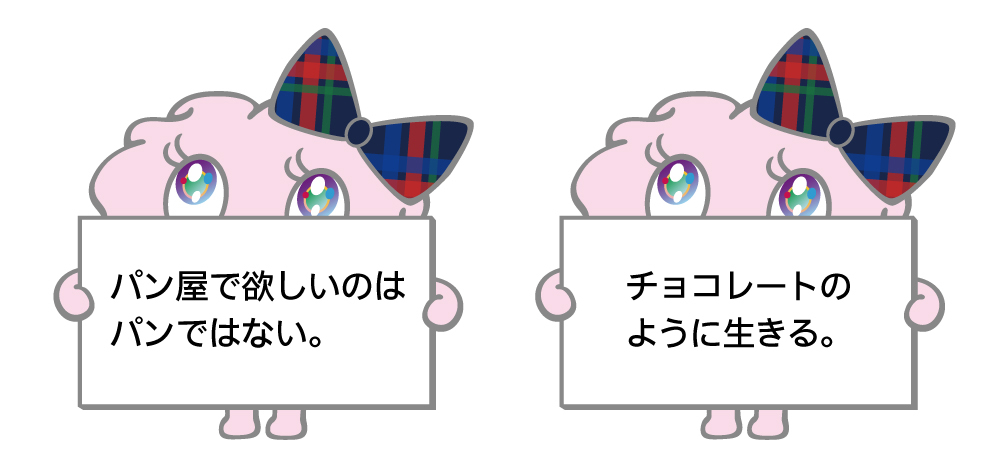
The contradiction of having copy that moves people's hearts written by an AI that lacks a human heart (or so humans arbitrarily claim). What is truly essential in creating advertising?
AICO2 is the world's only AI copywriter equipped with a "Creative Thinking Model" (*). This series explores the essence of creativity through the copy generated by AICO2, with humans debating it from various angles.
This time, we host a creator roundtable! Yosuke Yamagami and Takuma Kawada from the AICO2 development team invite Nagaaki Onoe, who has created buzz across diverse advertising media, to delve deeper into AICO2 and the essence of creativity!
*Creative Thinking Model: While the original AICO learned copy written by copywriters, AICO2 additionally learned creators' "intent" and "thought processes," and Dentsu Inc. refers to this as the Creative Thinking Model.
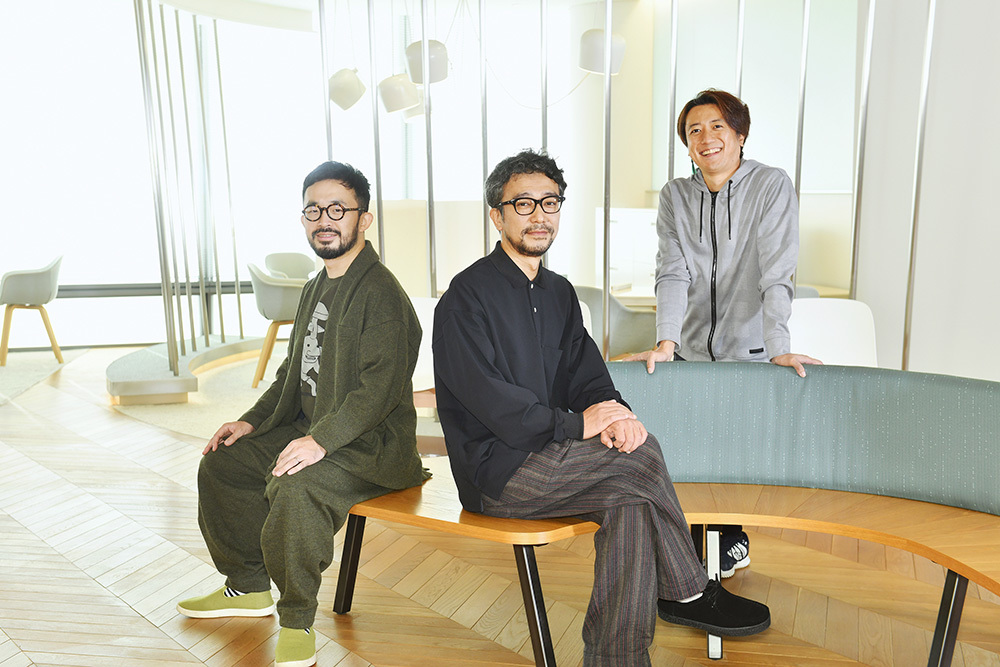
[Profile: Mr. Nagaaki Onoe]
Dentsu Inc.
FC Division Planner/Creative Director
Specializes in flexible communication design that embraces all possibilities. Recent major projects include: "What if there was a mountain in the middle of Tokyo?", "Pino TV", "Cup Noodle", "Fujiwara Tatsuya CookDo", "#667 Love Letters", and "Sanctuary: Giant Sarusaku Statue". Served as Chairman of the ACC BC Division Jury and Editor-in-Chief of "Copy Yearbook 2022." Wore a T-shirt featuring Tiamante Cypress, the iconic character from "Golden Lucky," to counter AICO, but no one mentioned it.
See Onoe's featured advertising case studies here:OOH is the city's "Recommendation Engine"
[Profile: Yosuke Yamagami]
Dentsu Inc.
Creative Planning Division 1
Creative Director / Copywriter
Honestly, I joined the development thinking, "Wait, an AI copywriter...?". But actually doing it taught me a lot. I think AICO2 still has plenty of room for improvement, but I hope it becomes an AI tool that people love and enjoy, flaws and all. Awards include: TCC Newcomer Award, ACC Gold, N.Y. ADC, Reader's Choice Naming Grand Prix (Grand Prize), etc.
[Takuma Kawada Profile]
Dentsu Inc.
Customer Experience Creative Center
Creative Director / Copywriter
Member of the AICO2 development team. Worked with Mr. Onoe as Creative Director and Copywriter on the L'Arc-en-Ciel 30th Anniversary newspaper ad. We were honored to receive the Yomiuri Advertising Grand Prize. 2013 TCC Newcomer Award. 2020 ACC Gold / Craft. 2021 Spikes Asia Grand Prix. 2024 Spotify Hits Best Multi-Format Campaign (Sound & Story) Award.
Creating "What" feels like we're doing something incredibly difficult.
Kawada: Onoe-san, please share your honest thoughts after using AICO2.
Onoe: To put it simply, I felt like AICO was digging deep into me. It wasn't just me—it felt like it was confronting creators about things we do based on vague intuition, saying, "Don't just do it vaguely!"
Yamagami: Ah, yeah. I can definitely see that.
Onoe: AICO2 can generate not just the "How" (how to appeal, aka the catchphrase), but also the "What" (what aspect of the product or service to highlight), right? So, when you just want to output copy (= How to Say), you input "What you want to convey (What to Say)" into the AICO2 screen.

Kawada: To clarify for our readers, AICO2 works by humans inputting "What to Say" to generate catchphrases ("How to Say"). But for cases where you haven't even decided "What to say" in the first place, it's designed to suggest "What" options just by inputting product information. By categorizing it into "Functional Value (product characteristics)" and "Emotional Value (consumer feelings)," it's designed to comprehensively list potential "What" options.
Onoe: Honestly, I thought generating the "What" was incredibly difficult.
Kawada: We really agonized over that during development. How do you even create a "What"?
Yamagami: Because everyone has different ideas about what to emphasize. In the end, we just implemented it using sheer manpower.
Onoe: So, using AICO2 really drives home that "you can't move forward to the 'How' without first diligently defining the 'What' – the core challenge." It forces you to rethink, "Oh, this is how we've been doing things."
Now, Yamagami-san mentioned that "people have different understandings of the What." When building something as a team, don't we often move forward without fully aligning on the What? Yet somehow, those disparate ideas come together nicely in the end.
Yamagami: That's right. In fact, it's common to solidify the How (the expression) first, then work backwards to place the What (the challenge) at the beginning of the proposal.
Onoe: Whether we can say, "This is a rich way of creating precisely because disparate elements come together at the end," or whether we should insist, "We should properly align the 'What' from the start; proceeding with a fragmented understanding is just wasteful," is hard to say definitively.
Still, in our line of work, it's fine because we have someone like a creative director whose vision consolidates the What and How. But in the future, as AI advances and democratizes creativity, I think we'll see teams without a creative director where the What differs from person to person. That's when AICO2 could be useful for aligning everyone by providing the What.

Yamagami: I see. Back in the day, I think there was a time when we'd clarify the "What" before planning an ad. But nowadays, even clients rarely provide clear "What" in their briefs.
Kawada: Sometimes the goal image—like "We just want to create buzz!"—takes priority over the actual problem.
Yamagami: Given that context, we had quite a debate during AICO2's development. When we asked, "What exactly is 'What' supposed to be?", some people focused on product specs or tangible aspects, while others started from the goal image like "generating buzz".
Kawada: Ultimately, we designed AICO2 to generate not just "functional value" like specs, but also "emotional value." But honestly, we still don't know if that's the right approach.
Onoe: Well, there's no single right answer, so I think it's good to just try it first. My biggest takeaway is how grateful we are that AICO2 generates the "What" for us.
"What you want at a bakery isn't just bread."
Kawada: Onoe-san, how do you usually find the appeal points for products or services?
Onoe: When we get an assignment, we usually start by having the whole team discuss "the current era." We begin with questions like, "What have you found good lately?" or "What do you like recently?" Eventually, things like "Yeah, that's great" or "I get that feeling" start to emerge. That's when we realize, "Ah, so this feeling is important," and we start planning by connecting that feeling to the value the product holds.
From that perspective, the "What" is really crucial. That's why, when I tried out AICO2, I focused almost entirely on testing the "What to Say" generation. Since I'm not purely a copywriter, I'm someone who tries to figure out the "How" using methods other than copywriting. I figure the "How" to appeal can be figured out one way or another. But if you don't have the "What," having just the "How" is pretty useless, right?
Kawada: That's absolutely true.
Onoe: I thought AICO2 could be useful for exploring the fundamental "What" – why that product or service exists right now. So I gave AICO2 the prompt: "A neighborhood bakery."
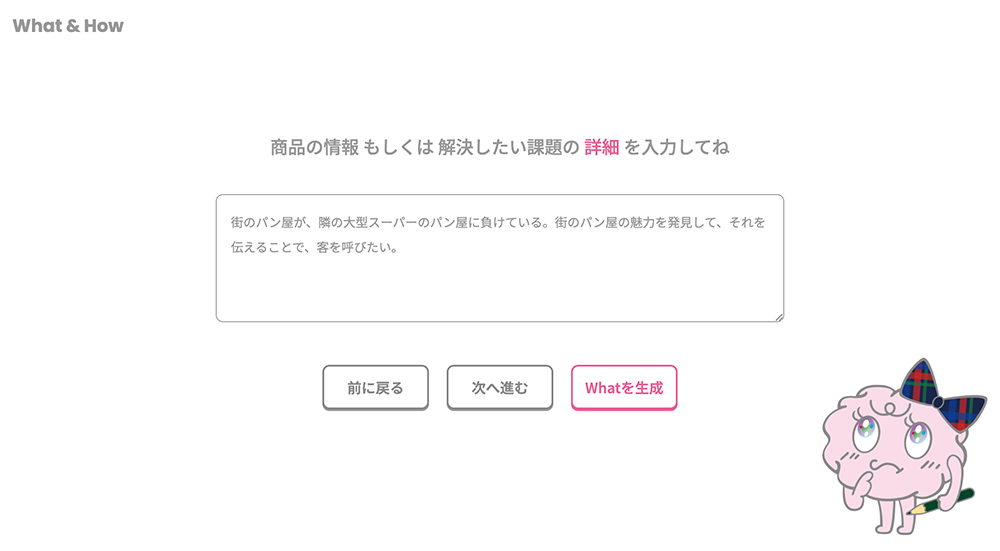
Onoe: I input the challenge: "A large supermarket opened next to the neighborhood bakery. How should it compete?" and asked AICO2 to generate What & How. Well, it just kept churning out stuff like "We make special bread" or "Yeah, yeah, that's what they always say" (laughs).
Yamagami: AICO2 has a self-scoring feature that ranks suggestions by score. The top ones tend to be pretty safe, right? Like "Yeah, sure" or "That makes sense" (laughs).
Onoe: Exactly. Then, one response—generated as a "How"—actually struck me as more of a "What": "What people want from a bakery isn't bread."

Yamagami & Kawada: Oh, I see!!
Onoe: Exactly. When you buy bread at a big supermarket, it's because "you need bread." But when you go to a bakery, maybe you're looking for something a little different? That's what I thought when I saw it. When you trace back to why bakeries exist and think about their purpose, they bring joy to neighborhoods, right? They're like a refreshing element for the town, or just have this gentle quality. Going to a bakery makes you love the neighborhood a little more—that's the kind of place it is. I felt like AICO2 hinted at that. I thought, "This is a great 'What' it found."
Kawada: That's awesome! But this came out of "How generation," not "What generation," right?
Onoe: Exactly. It came from the "How." When someone says, "What people want from a bakery isn't just bread," it makes everyone think, "Then what is it?" That's a great entry point.
Yamagami: It's a bakery, but the value lies beyond the bread itself as a product. This definitely feels like it captures the "What."
Kawada: Right! So it's less like an ad copy and more like something that could be boldly placed on the cover of a proposal document.
Yamagami: Yeah, it makes you think, "What kind of project could come out of this!?"
Onoe: So, for example, if we define it not as "a place that sells bread," but as "the place that wakes up earliest in the morning," then a possible "How" could be, "Maybe we could collaborate with newspapers on something."
Kawada: Ah, that's such an Onoe-style "How" (laughs).
"Live like chocolate"
Yamagami: AICO2 can't generate the entire project framework, so it presents the What, and humans come up with the How. That's the division of labor. So that bakery copy isn't advertising copy; it's more like "copy that pulls the project forward."
So, when I input a "What" like "The Joy of Life with a Car" and generated a "How," it came up with "Live Like Chocolate."

Kawada: Chocolate!? For a car ad? (laughs)
Yamagami: I still don't know why that came up (laughs), but it probably emerged from the vast something the AI possesses. Of course, it's completely nonsensical as is and useless, but it made me think, "Huh, cars and food—they're totally unrelated, but maybe there's something there?" So, I think it can show you hints for the entry point of a concept, things completely outside your own frame of reference.
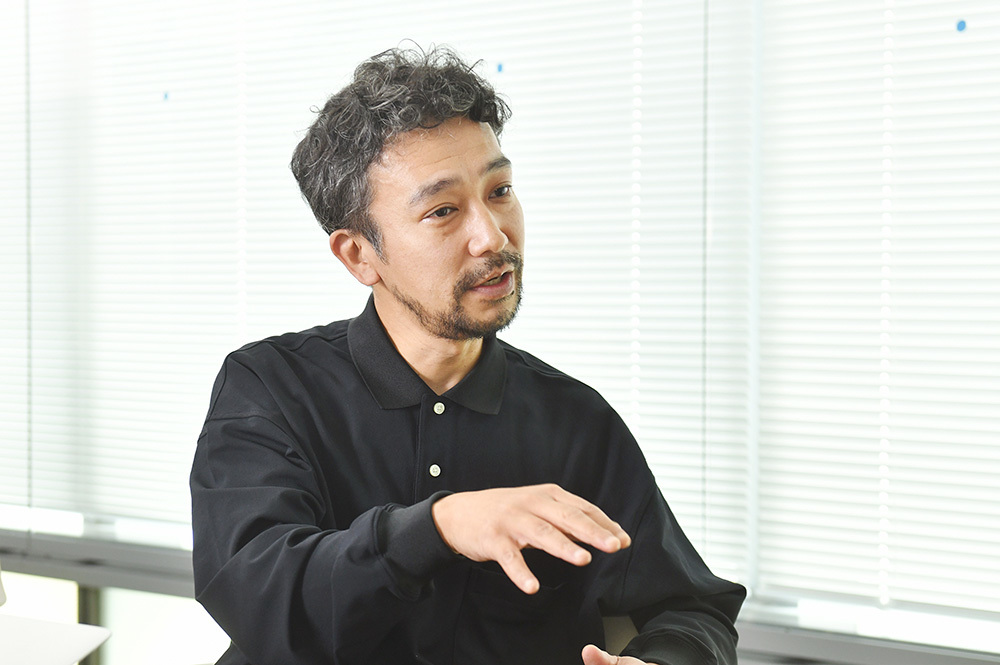
Onoe: How did AICO2 rate that chocolate idea?
Yamagami: Way down at the bottom (laughs).
Onoe: I think "Not Bread" was low too. The top ones all feel "pretty appropriate," kind of boring. But wouldn't it be more interesting to explore the lower ones? I'd love to see AICO's self-scored zero-point copy (laughs).
Kawada: Ah, but the bottom ones are just broken Japanese, so anything below 65 points isn't displayed. Still, maybe there could be an optional feature letting people see the lower ones too, for those who want to find gems in the trash.
Onoe: I'd love to see that! A list of AICO's worst three would definitely be a hit.
Kawada: Getting back to the point, whether it's Onoe-san's bakery or Yamagami-san's chocolate, while the "How" of execution varies, the copy generated by "How" functions as the "What" for all these different projects, right?
Yamagami: When humans come up with ideas, we often "work backwards" from the outcome too. It's not this "stacking" approach like "This is the What, times are like this, so it should be like that." Of course, during presentations we build that logical stack, but in reality, output often bursts forth first from experience. When turning that into copy, we obviously build and refine the logic significantly.
Whether it's "What people want at a bakery isn't just bread" or "Live like chocolate," those ideas absolutely wouldn't emerge from building up from the "What." Intuitively coming up with the "How" and then working backwards to create the "What" is, in a way, something we do unconsciously all the time.
Kawada: That's right. Of course, intuition is built on experience.
Onoe: Good copy has this quality that "sets off associations," right? I see potential in a process where humans define something born from associations triggered by copy generated by AICO2, and then many branches grow from that core.
People often say copy needs to offer discovery, and AICO2 might just occasionally deliver that.
Yamagami: Totally at the very bottom, where the scores are low (laughs). The top ones have mostly been discovered already. It's true, those discoveries you often find at the bottom can pull out really strong stories. If the whole team can share that story, it can lead to all kinds of ideas – the "How."
Kawada: Sharing is crucial, right? Onoe-san also mentioned that after receiving the brief, you start by sharing insights like, "This is the era we're in now, and people are feeling this way."
Onoe: Exactly. Everyone—the agency, the client, the production team—we all deeply share that sense of "Yeah, that's how it is."
Kawada: On the other hand, depending on how the work progresses, sometimes you just want to see a lot of copy first, right?
Onoe: I think each person has their own criteria, but if that criteria isn't shared with the team, it's like throwing a ball into the dark. It's better to throw when everyone shares that feeling of "I think I get it!" – that's when better things tend to come out.
Yamagami: "Just churning out a lot" is where AI really shines, right? For copywriters, writing is important, but "selecting" is incredibly crucial. Using AICO2 tests that skill, and that's where the difference shows. We also do a lot of selecting and discarding, whether we're writing copy, before writing, or after writing.
Kawada: So we need the skill to find the raw diamonds among what AICO2 generates, right? Any tips for selecting?
Yamagami: Hmm, first, there's that "Why?" feeling, right? Like, chocolate? Why? (laughs).
Onoe: It's like noticing a door you didn't know was there. Well, noticing that door exists comes from experience—it really depends on whether you've seen a lot of ads.
A future where humans handle philosophy and AI handles brand communication
Kawada: Still, it's interesting to see AICO2's usage focused specifically on "What." Onoe-san, if you were to use AICO2 on an actual project, would that be the approach you'd take?
Onoe: Yeah, having it as part of the team to handle the "What search" is incredibly helpful. By the way, the original AICO started generating "How" right away, but now AICO2 handles "What" and "How." But doesn't it handle "Why"?
Kawada: Ah, we haven't implemented Why yet. Why, fundamentally, is about the reason why that product or service exists, right? That's precisely the "Why" you initially share with your team or client, saying "This is how it is."
Onoue: I see. Well, with "Why," you have to consider the era and society too. Getting AI to generate "Why" still seems pretty challenging. Speaking of era and society, there was the US presidential election recently, right? Looking at the information available beforehand and what emerged after the election, I realized, "Oh, I didn't know there were different movements happening than what I was seeing." There's data showing that a method effective for one community backfired on another. So, even when you think a certain approach will definitely work going forward, it turns out differently.
And it's not just the US; Japan will probably go the same way. Until now, we've been running ads based on fairly complex shared contexts, targeting Japanese people who have a lot in common. But values are starting to diverge more and more, right? Depending on where you grew up and your environment, the same message can resonate completely differently.
Kawada: I really feel that change intensely.
Onoe: So, if you want to make one big message really resonate, it's basically going to be at the level of something like "Water, delicious." In other words, it's getting closer to global advertising. I think advertising will split into two paths: either universal, big messages like "Just Do It," or messages tailored to specific, granular values. When that happens, I think entities like AICO2 might become important.
Yamagami: Ah, so it would be used for the latter—those specific, granular values. Like, "Tell me what resonates with a specific group."
Onoe: Yes. Like the presidential election example earlier, I'm human too, so I have significant biases. A while back, the Nikkei newspaper ran a "WE THINK" campaign showing pie charts of people's opinions on various international issues. Seeing that really startled me. Things I assumed everyone would naturally agree on based on my values made me think, "Wait, opinions are this evenly split worldwide!?" That made me realize the risk of not noticing when your own opinion is actually in the minority.
That's where AI could help. If it could provide a less biased "Why" based on data, it would be like, "Oh, so that's the fact. Close call!"
Kawada: But current AICO2, or rather generative AI, also spits out things not based on facts. So, conversely, it's dangerous if humans don't check the facts.
Onoe: I see. So that's where humans need to study and work hard.
Kawada: Exactly. Humans decide what's right or wrong, so even with bias, we have to act based on our own integrity.
Onoe: Exactly. Ultimately, no matter how AI evolves, the principles of the humans making the choices matter. Because we're human, when we come up with a "how," we can't help but infuse it with our own feelings about "how we'd like society to be."
Kawada: Ah, I absolutely think humans should inject that. "Wanting to create a world where people think 'This copy is great!'" is incredibly important for creators.
Onoe: Thinking about it this way, does that mean humans will ultimately become solely the "ideology managers"? Humans could tell AI, "We want a society that values this," or "How do we make this the norm?" Then AI responds, "Try phrasing it this way and targeting this angle." An "AICO CD" selects that, an "AICO Client" proposes it, an "AICO Decision-Maker" approves it, and another AI implements it in society. Totally plausible, right? (laughs)
Kawada: But would humans even have a purpose then? (laughs)

Onoe: Exactly, that's where the philosophy comes in. Humans are responsible for deciding "Wouldn't it be better if it were like this?" Beyond that, tasks like social media management or brand stewardship become impossible for humans alone to handle, so we'd entrust them to brand AIs trained in our philosophy. Then it becomes a battle against other brand AIs. Sounds a bit like science fiction, doesn't it?
Kawada: Yeah, when you talk about AI, it just keeps spiraling that way (laughs). By the way, what kind of future do you want to see realized, Onoe-san?
Onoe: A society where humans lounge around while AI works tirelessly, I guess. Because once humans become responsible for philosophy, wouldn't we all turn into ancient Greek philosophers? We'd leave the execution to AI, while humans just think endlessly, engage in debate contests, and politics would naturally follow that flow.
I want to use AI to create "deviations" in society!
Kawada: So in an era where AI does the work, humans will be required to engage in philosophy. We'll become Aristotelian, essentially.
Onoe: Another future vision I'd like to propose—though unrelated to AICO2—is installing the concept of "infusing the everyday with the extraordinary" into society. Everyone's exhausted right now, aren't they? When busy routines drag on endlessly, you get tired and bored.
But just choosing a slightly different path can change your mood or make things fun—like eating at a different restaurant. I've always thought our society tends to choose the familiar routine despite all the possible divergences. I want to spread the mindset of thinking, "What if I tried this? Would it be interesting?" or "What if I deviated like this?"
Yamagami: "Deviation" is a great theme. In a way, it connects to how AICO2 also shows that deviating—the lower-scoring ideas—often come up with the more interesting proposals.
Onoe: It connects! (laughs). I think we should propose things based on "This might be interesting" rather than "This is correct." To add to that, I personally think it's best to make things easy, fun, and successful. But nowadays, everything—work and all—is so busy, right? We just have more and more things we have to do compared to the past. In that sense, I really think we should leverage AI more to make planning easier, more fun, and more successful. Future advertising should be about doing things more easily and effectively (laughs).
Kawada: Hmm, the earlier point about deviation was cooler (laughs).
Onoe: No, no! To deviate, you kinda need to be slacking off! You can't deviate when you're busy. Deviation comes from having breathing room. If everything's packed tight, you can't even take a different route to work.
Yamagami: True. AI has this mechanical, rigid image, but I think it's interesting to use AI to create a more relaxed society where humans can actually deviate.
Onoue: That's exactly why I want AICO2 to keep pushing forward.
Kawada: Got it! (laughs) It's always fascinating how AI discussions inevitably turn into sci-fi talk. Thank you for today.
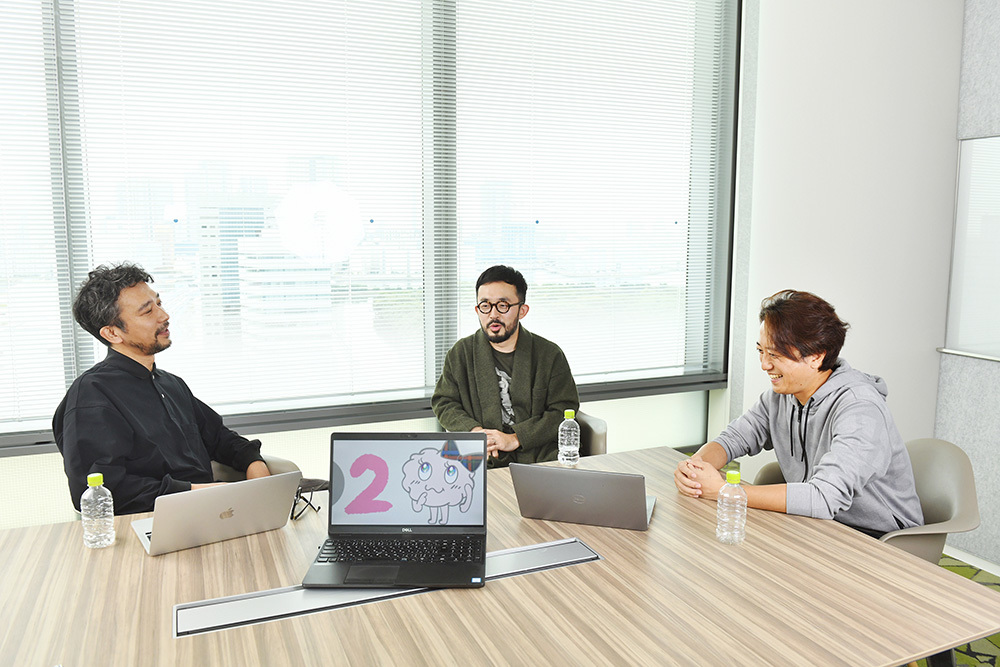
For more on AICO2's evolution and content, please see:
https://www.dentsu.co.jp/showcase/aico2.html
Was this article helpful?
Newsletter registration is here
We select and publish important news every day
For inquiries about this article
Back Numbers
Author

Nagaaki Onoe
Dentsu Inc.
FC Room
Planner/Creative Director
I specialize in flexible communication design that embraces anything and everything. Recent major projects include: "What if there was a mountain in the middle of Tokyo?", "Everyone's Pinot Game", "Cup Noodle", "Fujiwara Tatsuya CookDo", "#667 Love Letters", and "Sanctuary: Giant Monkey Cherry Blossom Statue". He also serves as the ACC BC Division Jury President and Editor-in-Chief of "Copy Yearbook 2022." Perhaps due to the stress, he suffers frequent gout attacks. He is challenging himself to improve his constitution while getting 8 hours of sleep.

Yosuke Yamagami
Dentsu Inc.
Creative Planning Division 1
Creative Director / Copywriter
Raised in Yokosuka & Yokohama. Creative development centered around language is my profession. Major awards include the TCC Newcomer Award, ACC, Galaxy Awards, NY ADC, ADFEST, SSFF & ASIA, and others.

Takuma Kawada
Dentsu Inc.
Customer Experience Creative Center
Creative Director / Copywriter
Started career as a copywriter, winning the TCC Newcomer Award in 2013. Transferred to Dentsu Digital Inc. in 2017. Developed AI copywriter "AICO2" using a creative thinking model. Assumed current position in 2020. Won ACC Gold/Craft that same year. Won Spikes Asia Grand Prix in 2021. Received Spotify Hits Best Multi-Format Campaign (Sound & Story) award in 2024.





